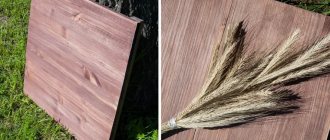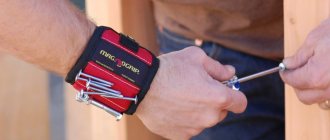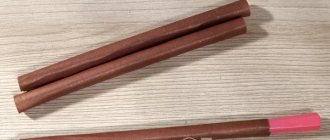How to make a scoop with your own hands?
This refers to a scoop for removing ash.
I can offer step-by-step instructions on how to make a metal scoop with a wooden handle with your own hands.
Here is a detailed drawing of a galvanized steel bucket indicating the locations and directions of bends, their radii, hole diameters, and angles.
So, the sequence of work:
- We cut a blank from a galvanized sheet, at least 1 mm thick, according to the specified dimensions. We do not drill holes for the rivets yet - it is better to do this on an already bent part.
- in order to make triangles for fastening a hexagonal wooden handle, we make slits with a grinder. It is better to drill holes for mounting screws before using the grinder.
If the farm does not have a hexagonal wooden block or there is no way to make one, you can use a square block, but then you will have to make your own markings for fastening.
- bend the workpiece along the dotted lines. To do this, we lay the workpiece along the bend line on the outer corner of the metal corner or channel. To prevent the sheet metal from stretching due to impacts, we use a wooden hammer (mallet).
- To give the structure additional rigidity, we make a false roll on the side of the handle on the upper edge (the sector is marked in red in the drawing).
We select the length of the handle at our discretion, but it should not be less than 20cm.
- screw the handle with self-tapping screws to the bent petals (triangles).![][ 6]
- As a result, we got this nice scoop.
Source
SCOOP WITH A TWIST
A dustpan for cleaning up garbage - it would seem that it could not be simpler. But no, and this elementary product has its own problems. In stores, scoops are sold in plastic (one-piece stamped) and with a metal scoop and a wooden handle. Both of them are not reliable: they break along the jumper at the junction of the handle with the vertical rear wall of the bucket. If you inadvertently press the scoop a little harder to the floor, a crack will form in the plastic, and plastic deformation will form in the metal bridge. Over time, defects accumulate, resulting in failure.
I, like many others, did not escape this trouble. Having “buried” a dozen purchased scoops, I decided to make my own - durable, reliable and technologically advanced. The result was a scoop consisting of 3 parts: a handle, a bushing and a bucket.
Handle - wooden; I turned it from an aspen blank on a lathe. (However, it’s loudly said about a lathe. It’s just that in my small home workshop there is a device based on an electric drill for turning small wooden parts.) After making it, I sanded it and coated it with furniture varnish. The handle turned out beautiful and comfortable.
The bushing and bucket were made of sheet steel 0.5 mm thick, followed by painting with nitro enamel (or you can use galvanized roofing iron). The thickness of 0.5 mm is optimal: it is sufficient to ensure the necessary rigidity of the entire structure, and on the other hand, it makes it quite easy to perform bending operations when forming parts.
Household scoop:
1 - handle (pine, birch, aspen...); 2 - bushing (steel, sheet s0.5 - 0.6); 3 - ladle (steel, sheet s0.5 - 0.6); 4 — rivet (3 pcs.); 5 — stopper (screw 3×10)
Forming the bucket and handle:
a, b - front leg of the bushing; c—bucket side; g - castle; d - rear outer wall of the bucket; e - rear inner wall of the bucket; g - base of the bucket; and - flanging; j - rear legs of the bushing; l — bushing body; 1 - bushing; 2 — scoop assembly; 3 - bucket formation
Attaching the bushing to the bucket (a - inside view; b - rear view)
To make the bushing, a steel mandrel with a diameter of 20 mm was used, the connection was made with a simple rebated seam. I cut the lower end of the bushing at a length of about 35 mm into 4 legs: one (front) approximately 20 mm wide, the rest (rear) narrower (10 - 11 mm). These tabs play a major role in ensuring the strength and rigidity of the bushing-bucket connection.
Making a bucket should be done in the following sequence:
- mark the contour and bend lines according to the development drawing and cut the workpiece from a 0.5 mm steel sheet;
— bend the flanges “and” by 180°;
— bend up the rear inner walls “e” of the bucket by approximately 75 - 80°;
— bend the sides “b” perpendicular to the base “w” of the bucket;
— first bend the lock “g” upward by 85 - 95°;
- bend the rear outer wall “d” perpendicular to the base, covering the halves of the rear inner wall “e” with the lock “d”;
- place the tab “a” of the bushing under the lock, and the tabs “k” from the outside to the rear wall of the bucket;
- press the lock together with the legs against the back wall and hold it in a compressed position using clamps;
— drill 3 holes in place for the rivets and use them to connect the bushing to the bucket.
The bushing's legs, wrapping around the back wall of the bucket on both sides, provide rigidity to the connection and prevent the occurrence of plastic residual deformations here. The result is the necessary strength and durability of the product.
One of the shovels I made is in the garden, and I even use it when doing excavation work when necessary. Purchased ones with such “cruel” treatment would have died long ago. And this one is alive and well!
DIY ash scoop.
At the school where I studied there was an excellent labor education teacher. To my shame, I no longer remember his name and patronymic, but the fact that he diligently tried to instill in us all sorts of skills is a fact! I was especially interested in all kinds of woodworking machines. The shavings are flying, the smell is amazing. Eeeehh..
Childhood, childhood. Where did you go?
No matter how hard my mother tried to create a “person” out of me, that is, not some kind of worker, but quite a boss, so that she could put her hands in her trousers and command the large masses, but fortunately nothing came of it to her. Why fortunately? Well, probably, if I became a boss, I wouldn’t be able to do a lot of things with my own hands, as I do now, for example. No, it’s not my thing to command, nor have I learned to obey. So I live as a lone wolf with my beloved She-Wolf. Yes.
So what am I talking about? A! Work. Lessons from labor! Yesterday the scoop that we use to take out the ash from the stove vent broke. And then I remembered these very lessons, I also remembered that there was a piece of galvanized sheet metal on the farm. Well, why not go to the store because of a scoop? And I, as an owner trying to be prudent, can I really afford to pay “insane money” for a piece of iron without trying to build that very piece of hardware from what I have?
“We had with us”: a piece of tin, a piece of profile PN 27x28 - popularly a wall edging, or a ceiling guide for installing “Gyprok”, several self-tapping screws for thin plates, popularly “bugs”, a hammer, metal scissors, a tape measure, construction square, metal scriber, grinder, screwdriver, anvil.
No, you can get by with a hammer, metal scissors and a screwdriver.
Source
First scoop option
The first scoop I made was from a suitable plastic milk bottle.
This is what he looks like.
By the way, such scoops of different sizes and for different needs can be made from plastic canisters of various capacities. The larger the canister, the larger the scoop.
This scoop is very easy to make.
To do this, you first need to cut off the excess part of the plastic bottle (or canister) with a construction knife.
Then trim the cuts with powerful scissors and finish them with fine-grained sandpaper.
This scoop turns out to be very compact, since its handle is on top.
However, this scoop was used for a very short time for sweeping up shavings, since it turned out that it was primarily very well suited for pouring and dosing various bulk products, for example, cereals, grains, chicken feed, etc. And for these purposes, they soon began to use it, and I made another version of the scoop.
Ash scoop and poker for stove maintenance
If you have a wood-burning stove in your house or dacha, then it must include accompanying accessories, namely an ash scoop and a poker.
These furnace maintenance items can be purchased. True, in some places they are unreasonably expensive. And the quality sometimes leaves much to be desired.
Therefore, if you have the necessary tools and materials, you can make an ash scoop and poker with your own hands.
We also recommend reading a review article on the topic: how to make a brick barbecue oven for a private home.
We will make a set for servicing the furnace from a square steel bar using the cold forging method.
To do this you will need a bending machine. If you don’t have a bending machine, you can make it yourself - read more here.
The simplest DIY sheet metal whistle
Anyone can assemble such a whistle. It will take no more than half an hour to make for a beginner. An experienced DIYer can assemble such a whistle in less than 10 minutes if he has the necessary materials and tools. This whistle is quite easy to blow and is quite loud. Alternatively, the whistle can be made from a sheet of copper or aluminum and then polished, just like a piece of jewelry can be engraved. It will be a pretty stylish homemade product. Materials and tools for homemade work: - thin sheet metal (suitable from a tin can); - paper; - pliers; — scissors (you can work with a tin can with ordinary scissors, however, they will become dull); - pen, felt-tip pen, pencil or nail (or another writing instrument).
Main stages of work
First of all, cut two square rods of the required length. After this, we make handles on a bending machine.
At the next stage, we clamp each workpiece in a vice in turn and twist the square into a torsion bar. You can also use a special machine for making torsion bars.
Next, we cut out a plate from sheet metal. According to the markings, we make cuts with a grinder. Then we bend the sides and weld the joints. As a result, we got an ash scoop.
With a poker everything is much simpler: we cut off a piece of metal strip, bend it and then weld it to the handle. Finished products need to be sanded and painted.
For details on how to make an ash scoop and a poker for servicing the stove, you can watch the video below. The review was created based on a video from the YouTube channel “Alexey Ayur”.
Source
Second scoop option
I made this scoop from a plastic ketchup bottle.
The technology for its manufacture is exactly the same as that of the previous scoop.
First, the excess part of the bottle is cut off with a construction knife, then it is finished with scissors and finally all the cuts are leveled with fine-grained sandpaper.
I must say that such a scoop turned out to be very convenient for sweeping away chips. In this case, the neck of the bottle is used as a handle, and the scoop itself has an optimal width, so that it is convenient to sweep shavings into it using a wide brush.
In addition, I additionally drilled holes in the top opening lid of the plug so that this scoop could be hung on the wall.
However, as it turned out, this scoop is also very convenient to use for pouring various bulk substances, and especially soil or humus for seedlings.
The fact is that the width of this scoop is just ideal for pouring soil into containers for seedlings made from cardboard milk bags.
Moreover, even if the container is narrow, you can pour soil into it through the handle of a scoop, that is, the neck of a former bottle, simply by removing the cap.
As a result, our women stole this scoop from me to work with seedling soil, for which it is still used to this day.
And after this incident, I decided to go a different way.
I thought that to sweep away the shavings, there is no particular point in making a solid, reusable scoop, but you can just make a disposable one, or rather, a scoop that can be used for only two or three months (just in winter), and then just thrown away.
And so, every time in the winter, I began to make a disposable scoop from a cardboard milk bag to sweep away the shavings.











